
|   |

|   |
 e-mail: sunilkothari1933@gmail.com Dance Conference at North Carolina University, Charlotte Photos courtesy: Kaustavi Sarkar May 29, 2019 Dance Department of North Carolina University at Charlotte in USA organized under the leadership of Assistant Professor, Odissi dancer Kaustavi Sarkar, an international dance conference titled 'Sensate Technicities, Dance Connecting Communities' in collaboration with Odissi International, and India Association of Charlotte from 3rd till 5th May 2019. From India, I was invited to participate. When I arrived on 2nd May, I came to learn that there was shooting on the campus and two students were killed. Not only that, there was another shooting in an apartment and one more person had died. The university campus was inaccessible, police had cordoned off the campus, and Kaustavi and her Head of the Dance Department were under great tension if the conference could take place or not under such circumstances. However, the situation was soon under control and the green signal given with revised schedule. On Friday the 3rd May in Robinson Hall in room number 330 South Asian Studies, there was an opening as some other program was cancelled. Kaustavi arranged my talk during the discussion of South Asian Aesthetics. Since I had the film on the legendary dancer Ram Gopal, it was decided to screen it as none of the dancers present and participating in conference had ever heard of him. The screening took all of them by surprise that besides Uday Shankar who had put Indian dance on the world map, Ram Gopal had with his solo performances put classical Bharatanatyam and Kathakali on the world map. Later on he had also choreographed The Legend of Taj, based on the historical story of Shahjahan and Mumtaz Mahal as a dance-drama at Edinburgh Dance Festival. I had interviewed Ram Gopal when he visited Delhi's Sangeet Natak Akademi. That was thirty six years ago. As per the rules of the Akademi, such archival material is not given for public viewing. As a concession, the Chairman allowed six minutes of our conversation where Ram Gopal speaks of his love for dance. He was a son of a Rajput father who was a lawyer and a Burmese woman. He was a very handsome man. As a child he loved dancing whenever at a nearby temple, drums were played. For Yuvaraj of Mysore, he would privately dance in garden parties. Then as per his talk he mentioned that a neighbor took him to a Kathakali show and he was floored. He had never seen anything like that. He went to Kerala Kalamandalam and studied Kathakali. His father was not happy as he wanted him to be a lawyer like him. His mother however did not mind. Ram Gopal said that later on he learnt from his mother that his grandmother had been a dancer. In early thirties, many had not seen Kathakali or Bharatanatyam according to him. Around 1936 or so, from New York, La Meri, an ethnic dancer came to India with her Italian husband on a dance tour of South East Asia. She visited Bangalore. She asked a theater manager if he knew any young male dancer who could join her company for a tour and perform Indian classical dance. The manager introduced her to Ram Gopal. She was impressed by his personality and invited him to join her troupe who were visiting Singapore, Malaysia, Philippines, Bali, and Java and from there they were to go to Japan. La Meri was a versatile dancer, knew several types of dances: Spanish, Ballet, Balinese, Indian dances of Marwari Nautch, also had studied Bharatanatyam. She would change her costumes quickly and performed with great agility. Ram Gopal was amazed at her versatility. It so happened that in Tokyo as per Ram Gopal's version, the press reviewed his performances more than those of La Meri, so she got jealous and dropped him from her troupe and abandoned him in Tokyo. Ram Gopal was devastated. A Polish program organizer supported him and took him from Japan to San Francisco and other parts of America. After that he returned to Bangalore, went to Kerala for further studies of dance and also to Pandanallur village to study Bharatanatyam under Guru Meenakshisundaram Pillai. He visited Europe, Paris, New York and made a big name. In London at Aldwych Theatre his shows were scheduled for a week and people thronged to see this 'Indian God.' Even the legendary Russian dancer Nijinsky came to see him. Ram Gopal settled in London and formed a group of dancers presenting Indian classical dance and short productions. He established a school of Indian dance in London but it did not take off. His partners were Satyavati, Shevanti and Kumudini Lakhia. He became a well-known dancer world over. One French director wanted to make a film on his life. Unfortunately he died, but his wife Claude La Morris took up the challenge and they came to India and made a film Om Shiva capturing some of the dances of Ram Gopal. I had accompanied him in Kerala and took him to his Guru Kunju Kurup and to Kerala Kalamandalam. To cut a long story short, let me talk about the film. From debris of Ram Gopal's mansion in Bangalore a small tin box was found which contained a colour film made by a photographer. This was given to designer, painter Ayisha Abraham, daughter of well-known cartoonist Abu Abraham. She was excited to see the film excerpts, and after reading his autobiography, collecting material and old photographs, made a small documentary film of approximately 17 minutes titled 'I Saw God Dance'. It incorporated Ram Gopal's Dance of Setting Sun (1947) and earlier film where he performs Bharatanatyam. Taking excerpts from film 'Om Shiva' made by Claude La Morris, she worked out his life sketches with actual danced excerpts and interviews with Kumudini Lakhia and me. He wanted me to write his biography which I did not as he did not want me to mention his birth date which was 20th November 1912. His mother used to call him Bisano, meaning bis twenty and No meaning November. The film captures some magic of his dance. Since no archival documentation was done then, he remained an unknown dancer in later years. Uday Shankar directed / produced a film Kalpana which gives us the idea of dances he choreographed and performed. There is little of Ram Gopal in those terms. The film created curiosity and we spoke of how Indian dances and later on classical dances became well known world over thanks to these pioneers. The young dancers and few parents who attended the screening were completely surprised to see this film and learn about him. The seniors including Odissi dancers Dr. Anurima Banerji of UCLA, Dr. Ratna Roy, now retired, of Evergreen College near Seattle, Dr. Rohini Dandavate from San Francisco spoke of importance of documentation and its relevance for dance studies. Sensate technologies: Inaugural session After the introduction of dance faculty, Dr. Ann Dils UNCC Dance Chair, there was a live Odissi music performance by Rupak Kumar Parida, Ramesh Das, Ekalabya Muduli, Gayatri Senapati and brief Odissi performances by disciples of Kaustavi - Imani Gaston, Shreyah Mohan Selvan, and Monae James. 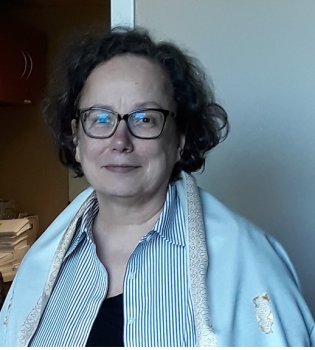 Dr. Ann Dils 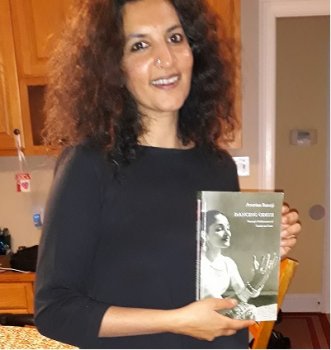 Dr. Anurima Banerji For UCLA, Dr. Anurima Banerji, Associate Professor in the Department of World Arts and Culture/Dance at University of California-Los Angeles, spoke on her latest book 'Odissi: Paratopic Performances of Gender and State', with cover of Indrani Rahman, which is published by Chicago University Press. It was to be also published by SeaGull publications, Kolkata, by 23rd May. Anurima Banerji had studied Odissi in Kolkata under Guru Muralidhar Majhi who was my colleague in Rabindra Bharati University. When I was a Fellow of Asian Cultural Council in New York University, Anurima had registered for PhD under Richard Schechter in Performing Arts Studies department. She was keen to undertake extensive research in Odissi and over more than ten years she did lot of work. She visited Odisha several times, visited temples, studied sculptures, based her further researches on the first ever book by Dhirendra Nath Patnaik on Odissi, took advice from archeologists, studied the temple architecture, drew conclusions with architecture and dance, interviewed Maharis, saw lithograph prints in British Library in London, interacted with musicians, saw performances of Odissi Jatra, and related forms pala music, folk dances and what have you. One of the drawings /prints she showed was of Rath Jatra and at the back of pulling the chariot she showed women dancing. Women were part of Rath Jatra and performing was not known to many of us. Her Paratopic view throws light on transformation of Odissi dance from its historical role as a regional artistic practice to its modern incarnation as a national spectacle, with a focus on the state's regulation of the dance form and the performances of gender embedded within it. Using an interdisciplinary approach that brings together social history, political theory, and dance and performance studies, the book explores three original themes: The idea of the state as choreographic agent: the performance of 'extraordinary genders', or those identities and acts that lie outside every day norms; and the original concept of the 'paratopia,' a space of alterity produced by performance. Through an investigation of these themes, she has explored how Odissi has shown the potential to challenge dominant cultural imperatives in India. Some of the illustrations in the book are published for the first time and throw considerable light on Odissi dance and its history. Scholarly work of outstanding discipline, the book is a valuable addition to the literature of Odissi dance, which extends the horizons of understanding of Odissi. Under 'Dance in education in America' session, Odissi International Juniors under 18 presented solo and group dance. This session only reflected the uneven standard of Odissi dance. However the purpose was to connect communities through dance. Having seen similar sessions in India, I was a little doubtful of such a project. Later on, I was given to understand that this was most important segment to bring local and other dancers from different states to showcase Odissi. If so, even then in an alien land over past thirty or more years, dancers who have been training, starting small dance classes has resulted in horizontal spread of Odissi. In America, Charlotte University has provided an opportunity to study Indian classical dance form of East India from Odisha state. Dancers were given 10 to 15 minutes each to perform to taped music. Some ten dancers performed various items like Pallavi, and in some cases abhinaya to Odiya songs. Some dancers had received training from traditional gurus in India like Guru Kelucharan Mohapatra, Deba Prasad Das, Mayadhar Raut, and Pankaj Charan Das. Those dancers who settled in Charlotte after marriage, started schools to teach what they had studied in India from these gurus. On 4th May there was a panel discussion on Centering Periphery. It was moderated by Dr Sreelina Ghose. We were some six participants. Dr. Ratna Roy from Seattle, Dr. Rohini Dandavate from San Francisco, E.E. Belasco, one of the faculty members from dance department, Purba Das, one organizer from the local community group and myself. The discussion was regarding if Odissi as a dance form was peripheral in American context? Was Odissi similarly peripheral in India vis-Ó-vis other dance forms? I was asked to comment about Odissi in India. I said that since I come from India and watch Odissi and its position, it is NOT peripheral so far it is concerned along with other dance forms of Odisha. As a matter of fact it has gained importance on par with other dominant dance forms like Bharatanatyam and Kathak. Rohini Dandavate spoke of cultural policy in which she has received her Doctorate from Ohio State University. She also has experience of working in Arts Administration. In American situation compared to other dance forms like classical ballet and modern dance, it was obvious that Odissi would be peripheral. However, she was of the opinion that despite it being peripheral its training inculcates among learners discipline, identity and self-esteem. Dr. Ratna Roy spoke of the difficulties she had faced to introduce Odissi dance at Evergreen College. Her basic PhD was African American literature. But she opted for teaching Odissi dance in the institution. She built up a commendable repertoire based upon Guru Pankaj Charan Das's style. She trained American students and also choreographed a dance-drama based upon the story of Jhansi ki Rani. It showed the strong feminist approach. Instead of treating Odissi as peripheral she strove to make it relevant for study. 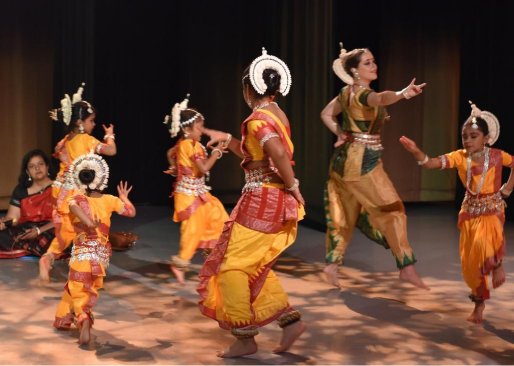 UNC Charlotte and Charlotte community program 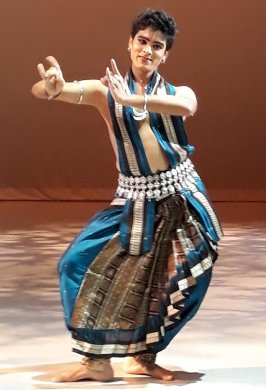 Soumya Bose (Photo: Dr.Sunil Kothari) The representative of a community group took the view that even if the standard could not be very high, the children who can learn dance was more important. When there is community gathering and dance is being performed, it brings camaraderie and the celebration of annual meeting is enjoyable. He was of the opinion that if dance is taught at the university level - which was a surprise for him seeing the activities and so many young dancers participating - he felt that dance was not peripheral activity. The member of faculty, a male dancer who hailed from Philippines, spoke of his experience that he was not trained in his mother tongue as he was to work in America and he did not study his mother tongue or his native dances. Thus for him dance was not peripheral because he was in a different country where his native dance was not a part of dance. The general opinion was that even if Odissi was peripheral, it was important to have it for training. Sujata Mohapatra's disciple Soumya Bose's performance stood out for his thorough training under Sujata and excellent body postures, clarity of movements and good command over tala and laya. He has made praiseworthy progress in recent years under Sujata's training. The performances by other participants who came from different states of United States numbered more than 16 and from 10.30am to 1pm they presented various Odissi numbers, major ones being Pallavi. Two very young dancers, who looked like sisters, performed Pankaj Charan Das's style. Guru Pankaj Charan Das had taught a dance number which was known as Thali Dance. It is similar to Kuchipudi. I have seen it performed by only Ahalya Hejmadi, daughter of Priyambada Hejmandi, who had studied it. Generally it is not in the repertoire of other gurus. The two together performed to the song "Dekho go Radha sange nachanti" - O friend, watch how Krishna is dancing with Radha. Sometimes both danced together showing how Krishna performed. And sometimes one became Krishna and other Radha. It was very innocent and charming. They were trained by Dr. Ratna Roy. It would be invidious to single out dancers who were very good. The seniors in their age group had more experience and those who had come on their own after applying to participate expressed anxiety to carry on the tradition against all odds. Niharika Mohanty, a senior dancer, expressed her desire that all Odissi dancers should get together and present Odissi on par with classical ballet. Pratap Das from Washington DC had organized international Odissi dance festivals for few years with the same desire bringing Guru Kelucharan Mohapatra, Gangadhar Pradhan, Kumkum Mohanty, Minati Mishra and others to showcase the excellence of Odissi. But it was difficult to sustain year after year. Once he organized International Odissi Festival in Bhubaneswar and later on the government stepped in and took up the initiative. Shyamhari Chakra started Odissi Annual Festival on modest personal scale. He spread it to international level with help of parents from abroad who were keen to present their offspring. After ten years, this year he has declared that he would discontinue working and revert to writing and research. 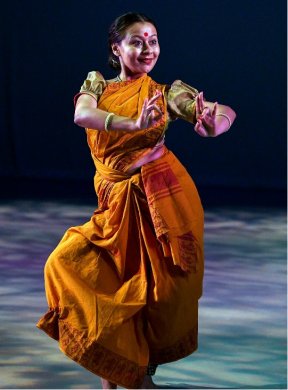 Kaustavi Sarkar ; Photo: Arun Kumar 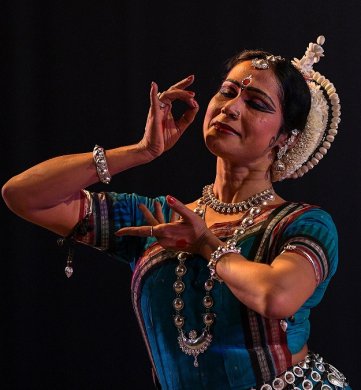 Sujata Mohapatra Featured performance in the evening after 7pm was by the celebrated Odissi exponent Sujata Mohapatra, disciple and daughter-in-law of Guru Kelucharan Mohapatra who has won universal praise as one of the best exponents. Earlier Kaustavi performed a number choreographed by her guru Paushali Mukherjee, who in turn had studied from Kelubabu. Kaustavi performed with Úlan and danced joyously depicting monsoon, dance of peacock evoking the mood of rainy season. After her, the main performance by Sujata Mohapatra with live music was presented. There was a rush for her performance and according to rules for preventing fire, only limited number of 50 persons could be admitted to the auditorium. Young Odissi dancers and children sat on the floor. Some volunteered to leave after two items and others waiting outside were admitted. Though it was planned to have a bigger auditorium, because there was no backdrop, Sujata decided to perform in the hall where all dancers were presented. Of the numbers she presented, the ashtapadi from Gita Govinda, "Sakhi he keshi mathanamudaram" saw her Radha enactment - as a bewitched nayika, her first union with Krishna, her going to meet him stealthily as abhisarika nayika et al were exquisite. Sujata's performance often scales great heights. There is indefinable magic in what she performs. Her total sadhana has placed her in a class of her own and people flock to see her. She does not disappoint. Be it Bhubaneswar or Boston, New Delhi or New York she performs with such sincerity following her guru's style. She selected sequences from Ramayana. Rama and Sita together in Panchavati enjoying the beauty of nature, Ravana sends Maricha as golden deer, Sita is enchanted and begs of Rama to bring the deer unto her. He leaves asking Lakshmana to look after Sita. When shot by Rama, Maricha cries aloud for Lakshmana. Sita sends him away despite Lakshmana's protest that Rama cannot be killed. Sita accuses him that he has different intentions and compels him to leave. He draws three lines and warns Sita not to cross them. One line has fire, other has serpent and no one can enter these lines. Ravana comes in disguise as mendicant begging alms, asks Sita to step out and give, and kidnaps Sita. She realizes her mistake and throws her ornament when Ravana lifts the earth on which Sita was standing and placing her on chariot flies away. When Jatayu sees this, he confronts Ravana who cuts off one wing. In search of Sita, Rama arrives on the spot where Jatayu lay wounded. Rama comes to know in which direction Sita was being taken away. He pays his respects to Jatayu who achieves moksha. Sujata enacts each character with consummate artistry invests it with life, bringing the characters alive. The principle of ekaharya lasyanga of Natyasastra, one actor performing various roles, find full expression in Sujata's abhinaya. And audience is under her spell. The finale with Rama holding the bow with rock steady stance leaves an indelible impression and the audience bursts forth into loud applause giving her standing ovation. The musicians are introduced and Sujata invites few of us to comment. What can we comment being under the spell of her presentation! Sujata had arrived after performing in New York in the series of Dancing Gods which Rajika Puri presents with introduction. Alastair Macaulay, the former dance critic of The New York Times, confesses that he is in love with Odissi dance form of all the classical dances. And Sujata is one of the best exponents. His praise echoes our responses. 'It's daft to call anyone the world's greatest dancer, isn't it? Still, that label keeps recurring to me as I watch Sujata Mohapatra, the sovereign Odissi dancer who returned to New York for a performance tonight. Again and again she reveals different aspects of the sublime; and we sense marvels of phrasing, rhythm, shape, line, gesture, stillness and complex coordination of her movement that open different windows on to what dance can convey. Odissi, a form virtually extinct at the end of British Raj, has undergone a glorious renaissance in recent decades of this century. I have been taken to the heights by Madhavi Mudgal (and more recently her niece Arushi Mudgal) and the two deities of Nrityagram, Surupa Sen and Bijayini Satpathy. We don't need to choose between them but watching any of them, my heart often chooses Odissi above all other dance forms (and not just the dance forms of India). Sujata often seems the most classical of all these, one whose recitals covers the greatest stylistic span with complete command. She combines ultimate objectivity and clarity with an architectural and expressive control of every nuance. Just as you are ravished by the perfect line and virtual detachment of one moment, the muscles in her face shift subtly and you are drawn differently into deep absorption of her performance. Without any apparent effort she keeps a percussion marcato rhythm going in her feet while everything from her pelvis to her head, eyes, arms, and hands is involved in a rich legato that sends currents rippling upward into the air above her. ('Written and posted on Face Book on Sunday, April 28, 2019.) 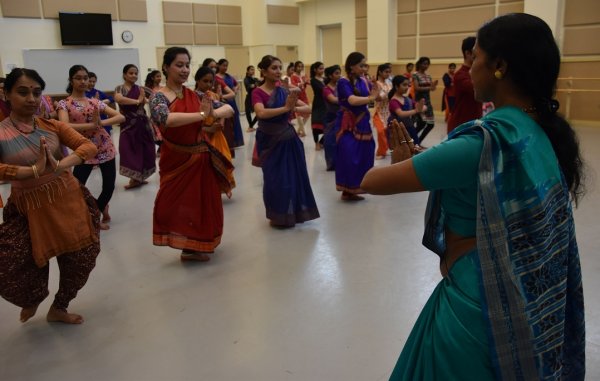 Workshop by Sujata Mohapatra On 5th May, Sujata conducted workshop where fifty dancers had registered. They have received advanced training. Sujata polishes up their movements explaining the basic stance, principle of how to maintain correct posture, and if not done properly how awkward it looks. Watching it I realized that what she has studied over more than fifteen years, she is able to train the young generation with her experience. She demonstrated the various hasta mudras for which Guruji has given the names like chalakeshmukti mayurasya, chibuk mandana, taranga alapalava, parshva mayurasya, lolita, positions of body and placing of feet as in kumbha chauka, uttolita pada. It was an eye opener for me to watch a workshop class, where one as a critic learns better appreciation of the technique. There was a brown bag lunch event with Gretchen Alterowitz who spoke about process of choreography. Kakali Paramaguru, a PhD candidate from Temple University, spoke in detail about how she would interpret Radha's character in Odissi. However, whether Radha was an imaginary character or real woman was a debatable question. As parakiya nayika would it be considered presenting her as a rebellious woman who defies social norms being in love with Krishna, though married to another man? Kakali's presentation of ashtapadi in the afternoon, to me looked regular one and not reflecting Radha as a rebellious woman. Such interpretations would demand more investigation and may be explanation given by the dancer in her choreographer's note. Else what one would see will look like a regular solo Odissi performance. The day concluded with many performances and one Bharatanatyam performance by a disciple of Maha Gingrich. Maha is a major Bharatanatyam guru, choreographer and a dancer in Charlotte. She was away in India, therefore we missed her 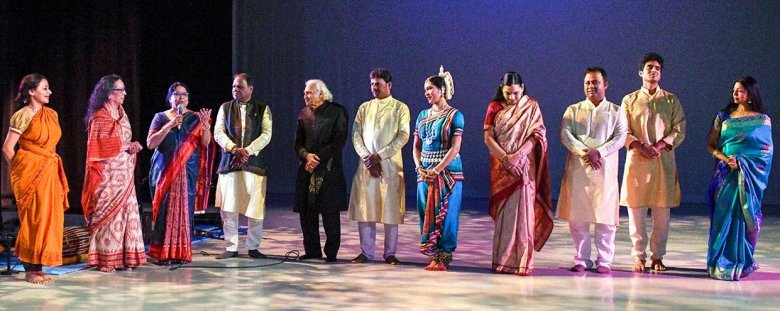 From left: Kaustavi Sarkar, Dr. Ratna Roy, Dr. Rohini Dandavate, Ramesh Das (violin), Dr. Sunil Kothari, Ekalabya Muduli (mardala), Sujata Mohapatra, Tikkimmena Patanaik, Rupak Kumar Parida (vocalist), Soumya Das (manjira), Niharika Mohanty Photo: Arun Kumar During the dinner, Kaustavi asked for feedback and improvement for future conference. It was suggested that it should be focused on Odissi only and not other dance forms. There should also be a curating for presentation of various participating dancers. Academic sessions must have presentations of papers and discussion. The abstracts be presented in advance and papers need not be read but discussion can take place and papers be published after the conference was over. Several suggestions were made for applications for grants from private sources besides the regular sources open to University for such conferences.  Dr. Sunil Kothari is a dance historian, scholar, author and critic, Padma Shri awardee and fellow, Sangeet Natak Akademi. Dance Critics' Association, New York, has honoured him with Lifetime Achievement award. Post your comments Please provide your name and email id when you use the Anonymous profile in the blog to post a comment. All appropriate comments posted with name & email id in the blog will also be featured in the site. |